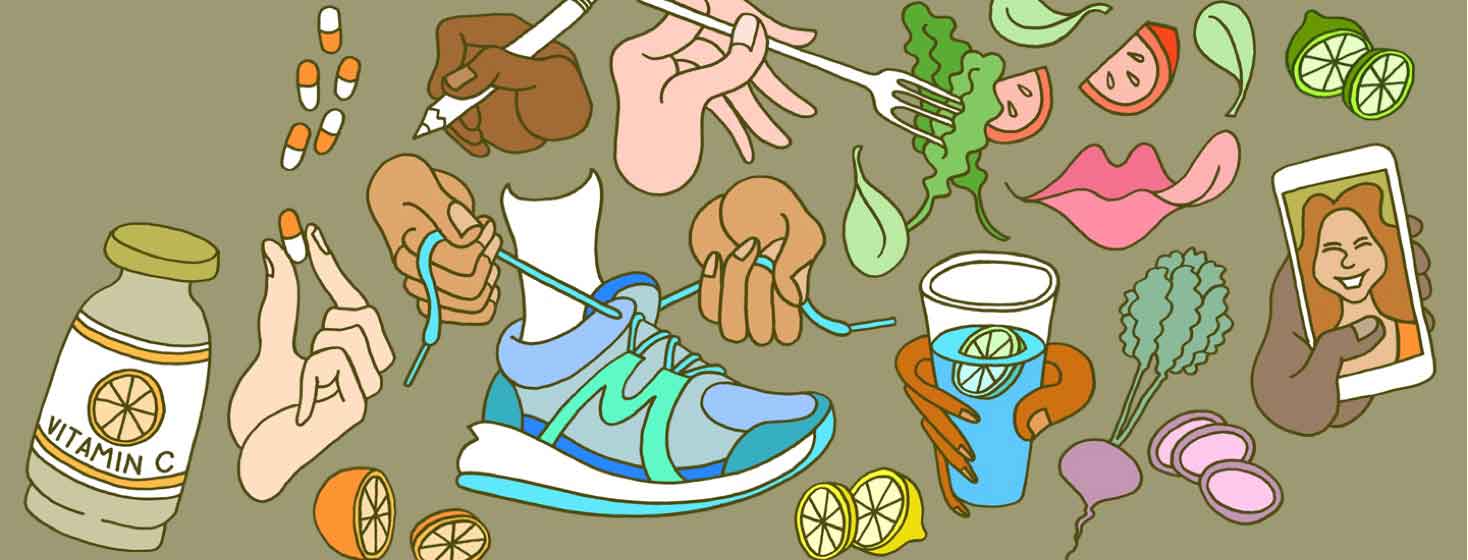Nutrition and Exercise With Adult-Onset Still’s Disease
Reviewed by: HU Medical Review Board | Last reviewed: February 2023 | Last updated: July 2023
Adult-onset Still’s disease (AOSD) is a rare type of arthritis that can cause pain and joint damage. It is often managed with medicines that work on the immune system to reduce inflammation. These drugs can help prevent further joint damage and other related health problems.1
However, there are also certain lifestyle changes that people with AOSD can make to help manage their condition. Many of these changes center around diet and exercise.2-4
Maintain a healthy weight
Each person’s experience with AOSD-related joint issues will be different. Some will have periods of flare-ups where symptoms get worse. Over time, this chronic (long-term) inflammation will take a toll on their body.2
One way to help lessen the impact of this damage is to avoid putting extra strain on the joints. When you are over a healthy weight, your joints take on added stress. This can cause additional problems alongside AOSD. Maintaining a healthy weight helps your joints function smoothly and is an important part of a good AOSD treatment plan.2-4
Featured Forum
View all responsesEat a balanced diet
Maintaining a healthy weight starts with eating a balanced diet. A well-balanced diet includes lots of fruits, vegetables, whole grains, and protein. There are even certain foods that can reduce inflammation. Eating a diet rich in these anti-inflammatory foods, and avoiding those that promote inflammation, may help ease symptoms.5,6
Examples of foods or spices that can help fight inflammation include:5,6
- Whole grains that are high in fiber
- Vegetables
- Fruits
- Beans
- Foods that contain monounsaturated fats (avocados, nuts, nut butters, and olive oil)
- Foods that contain polyunsaturated omega-3 fats (chia seeds, salmon, flaxseeds, and walnuts)
- Dark chocolate
- Tea and coffee
- Ginger
- Turmeric
Foods to avoid because they may promote inflammation include:5,6
- Sugary drinks (juice, sweetened iced tea, or soda)
- Simple or refined carbohydrates (pasta, rice, white bread)
- Saturated fats or foods high in processed fats (butter, bacon, sausage, full-fat cream)
- Fried foods
- Large amounts of alcohol
Before beginning any new diet, talk to your doctor. They may want to add a nutritionist or dietitian to your healthcare team. Some clinics also have programs that can help you get fresh groceries or make meal plans.
Create a strong exercise plan
Exercise also plays a big role in maintaining a healthy weight. In people with AOSD, exercising helps keep joints from getting stiff and may help slow joint damage. Strengthening muscles that support the joints can also help keep them functioning at their best. This is important in preventing disability or trouble carrying out daily tasks.2-4
A good exercise plan involves getting some form of moderate physical activity a few times a week. What is considered “moderate” may differ for different people. The most important thing is finding a plan that is safe, enjoyable, and something you can stick to. Examples of exercises that can vary in intensity and also bring joy include:2-4
- Dancing
- Swimming
- Walking with a friend
- Cleaning
- Gardening
Before you start any new exercise plan, talk with your healthcare team about the best plan for you. They can tell you if you have any limitations or make suggestions. They can also help connect you with physical or occupational therapists who can help make sure you are doing the exercises in a way that will not hurt you.
Consider taking vitamins and supplements
You need a variety of vitamins and minerals for your body to function well. When you eat a balanced diet, you often get enough of these naturally. But in some cases, taking extra of (supplementing) certain things can be helpful.3,5
For example, one possible side effect of steroids is weakened bones. If you are taking steroids for a long time, taking a vitamin D or calcium supplement may be helpful in protecting your bones.3,5
However, not all supplements are good for you. In the United States, over-the-counter supplements are not regulated by the Food and Drug Administration (FDA) the way other drugs are. They may not contain exactly what they claim to. Also, some supplements, especially those with herbs in them, can interact with prescription drugs. Before starting any new vitamin or other supplement, talk with your doctor.7
Effects on fatigue and mood
Diet and exercise affect more than just physical symptoms. They can affect energy levels too. For example, eating well and staying active can help lessen overwhelming tiredness (fatigue). Fatigue is a common symptom of AOSD and can have a huge effect on your quality of life.2-4
Regular exercise and a balanced diet can also improve mood and reduce stress. This may be especially helpful when you are dealing with the emotional and mental toll of living with AOSD over a long period of time.2,4

Join the conversation